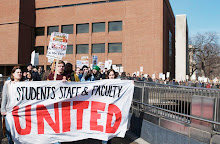The CHE had two great pieces this week on issues affecting the sciences. As most of you know, the U has put a lot of skin in the game in expanding the biomedical sciences. The numbers they ran for the feasibility of the project depended heavily on the ability of faculty to secure grants to support their research and their salaries. These two articles question whether these assumptions are valid...and whether scientists spending all of their time writing grants is the best way to advance scientific research.
In Science by Proxy, Toby Carlson argues that "how scientists get money for their research stifles, rather than spurs, creativity." The failure rate for grants is so high that academic scientists spend most of their time writing proposals, leaving much of the thinking to be done by grad students and postdocs...ergo "science by proxy." Teaching? Who has time! It doesn't help, of course, that success in obtaining grants determines the fate for professors' salary, tenure, and promotion. Faculty are put in the wringer as funds for scientific research decline--more people chasing after less money. The administrators have put our science colleagues on the hamster wheel. "Professors are not spending their time wisely if they are using most of it to write failed proposals." Not to mention that the feds may not be promoting the most important or creative research agendas. His solution:
...funding agencies should collaborate with academic scientists by agreeing to award qualified faculty members a nominal sum of money each year—say, $20,000, including some overhead for the university—plus one graduate student. The award would be based upon submission of a very short proposal justifying the research and citing papers published. Proposals requesting greater funds would still be submitted in a more lengthy form (subject to the current review process), but there would be less pressure on faculty members to constantly submit them. The total amount of money handed out would be far less than at present, and the time spent fruitlessly chasing funds with contrived research proposals would be reduced considerably. Scientists' productivity and creativity would increase, and the burden placed on reviewers and journal editors would decrease. Research would be initiated by working scientists rather than the agencies. In other words, bottom-up science.
Note: this practice would also help to control the unsustainable expansion of Big Science, which depends on leveraging grants to cover faculty salaries. Why not just hire people, pay them a decent salary, and have the grants be purely for research costs? Sure, we'd be smaller, but there'd be more academic and intellectual integrity to our endeavors, and they would also be more sustainable and avert escalating cross-subsidies from tuition-generating colleges.
In an essay that fits very nicely with Science by Proxy, Lior Shamir predicts that the bio-med bubble will burst. He notes that lead scientists are constantly on the hunt for more grants to sustain their work, since universities usually only cover their salaries and start-up costs for a limited period of time. "Such a system allows universities and research institutions to hire more scientists and expand their research at little cost to the institutions themselves, while enhancing their own reputations and academic prestige." The increase in applications for career development grants from the NIH is staggering--from 1,029 in 1997 to 3,340 in 2007. During the same period, the success rate plummeted from 51 percent to 31 percent. Unfortunately for our colleagues, the NIH budget has been flat since 2003, so it will only get worse, since in spite of budget constraints, universities have not lost their appetite for expansion in the sciences.
Shamir's solution:
...change the NIH's grant-making policy to require that a principal investigator's salary—or at least a substantial part of it—be paid for by the investigator's home institution. The National Science Foundation has already adopted such a policy, providing no more than two months' salary for a P.I. per year. Clearly, if adopted by the NIH, such a policy would reduce the number of positions offered by universities and research institutions, slow down the growth in the number of available P.I. positions, and further increase the pressure on the academic job market. But the upside is that universities and research institutions, if forced to bear the financial burden of hiring and paying investigators themselves, would plan their hiring strategies far more carefully.
Saturday, October 23, 2010
Subscribe to:
Post Comments (Atom)


Naturally, I have been hammering away on this point for some time - years actually...
ReplyDeleteFor some additional reading on the topic of this excellent post:
October 20, 2010
Is the Biomedical Research Bubble About to Burst?
(How will this affect the University of Minnesota?)
link: http://bit.ly/9UEiDT
May 1, 2007
If You Build It, Grants Will Come? Or, Could Someone at BigU Please Be Honest and Responsible About Expansion of Biomedical Research?
link: http://bit.ly/ddxKlE
April 25, 2007
Trees Do Not Grow to The Sky or, Why the State Legislature Should Not Write a Blank Check to BigU for Biomedical Research Buildings
link: http://bit.ly/d5E7px